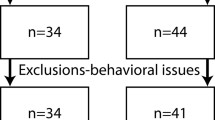Abstract
The present study examines the relationship between autonomic activity and cognitive/language delays in children with autism spectrum disorder (ASD). Baseline levels of respiratory sinus arrhythmia (RSA) and heart period (HP) were assessed in 23 4–7-year old children diagnosed with ASD. The relationship between RSA, HP, and ASD behavioral symptoms was examined. Similar to prior studies on typically developing children, lower basal RSA was related to more caregiver-reported language and cognitive delays, and to the lack of language.
Similar content being viewed by others
References
American Psychiatric Association. (2000). Diagnostic and statistic manual of mental disorders (DSM-IV-TR) (4th ed. text rev. ed.). Washington, DC: American Psychiatric Association.
Bal, E., Harden, E., Lamb, D., Van Hecke, A. V., Denver, J. W., & Porges, S. W. (2010). Emotion recognition in children with autism spectrum disorders: Relations to eye gaze and autonomic state. Journal of Autism and Developmental Disorders, 40(3), 358–370. doi:10.1007/s10803-009-0884-3.
Constantino, J. N., Davis, S. A., Todd, R. D., Schindler, M. K., Gross, M. M., Brophy, S. L., et al. (2003). Validation of a brief quantitative measure of autistic traits: Comparison of the social responsiveness scale with the autism diagnostic interview-revised. Journal of Autism and Developmental Disorders, 33(4), 427–433. doi:10.1023/A:1025014929212.
Constantino, J. N., & Gruber, C. P. (2007). Social responsiveness scale (SRS). Los Angeles, CA: Western Psychological Services.
Hudry, K., Leadbitter, K., Temple, K., Slonims, V., McConachie, H., Aldred, C., et al. (2010). Preschoolers with autism show greater impairment in receptive compared with expressive language abilities. International Journal of Language and Communication Disorders, 45(6), 681–690. doi:10.3109/13682820903461493.
Lewis, G. F., Furman, S. A., McCool, M. F., & Porges, S. W. (2011). Statistical strategies to quantify respiratory sinus arrhythmia: Are commonly used metrics equivalent? Biological Psychology, 89, 349–364. doi:10.1016/j.biopsycho.2011.11.009.
Lord, C., Rutter, M., & Couteur, A. (1994). Autism diagnostic interview-revised: A revised version of a diagnostic interview for caregivers of individuals with possible pervasive developmental disorders. Journal of Autism and Developmental Disorders, 24(5), 659–685. doi:10.1007/BF02172145.
Patriquin, M. A., Scarpa, A., Friedman, B. H., & Porges, S. W. (2013). Respiratory sinus arrhythmia: A marker for positive social functioning and receptive language skills in children with autism spectrum disorders. Developmental Psychobiology, 55(2), 101–112. doi:10.1002/dev.21002.
Porges, S. W. (1985, Septmeber 27–30, 1985). The vagal tone monitor: application in sleep research. Paper presented at the IEEE Engineering in Medicine and Biology Society, Chicago, IL.
Porges, S. W. (2007a). A phylogenetic journey through the vague and ambiguous Xth cranial nerve: A commentary on contemporary heart rate variability research. Biological Psychology, 74(2), 301–307. doi:10.1016/j.biopsycho.2006.08.007.
Porges, S. W. (2007b). The polyvagal perspective. Biological Psychology, 74(2), 116–143. doi:10.1016/j.biopsycho.2006.06.009.
Porges, S. W., & Bohrer, R. E. (1990). The analysis of periodic processes in psychophysiological research. In J. T. Cacioppo & L. G. Tassinary (Eds.), Principles of psychophysiology: Physical, social, and inferential elements (pp. 708–753). New York: Cambridge University Press.
Staton, L., El-Sheikh, M., & Buckhalt, J. A. (2008). Respiratory sinus arrhythmia and cognitive functioning in children. Developmental Psychobiology, 51(3), 249. doi:10.1002/dev.20361.
Tannenbaum, K. R., Torgesen, J. K., & Wagner, R. K. (2006). Relationships between word knowledge and reading comprehension in third-grade children. Scientific Studies of Reading, 10(4), 381–398. doi:10.1207/s1532799xssr1004_3.
Van Hecke, A. V., Lebow, J., Bal, E., Lamb, D., Harden, E., Kramer, A., et al. (2009). Electroencephalogram and heart rate regulation to familiar and unfamiliar people in children with autism spectrum disorders. Child Development, 80(4), 1118–1133. doi:10.1111/j.1467-8624.2009.01320.x.
Acknowledgments
The authors would like to thank: Dr. Julie Dunsmore, Dr. Thomas Ollendick, Dr. Stephen Porges, Elgiz Bal, Conrad Baldner, Katie Lansing, Douglas McKeown, Maggie Mooney, and Chad Stephens for their assistance with this study. This research was supported by a graduate research grant from the Organization for Autism Research.
Author information
Authors and Affiliations
Corresponding author
Rights and permissions
About this article
Cite this article
Patriquin, M.A., Lorenzi, J. & Scarpa, A. Relationship Between Respiratory Sinus Arrhythmia, Heart Period, and Caregiver-Reported Language and Cognitive Delays in Children with Autism Spectrum Disorders. Appl Psychophysiol Biofeedback 38, 203–207 (2013). https://doi.org/10.1007/s10484-013-9225-6
Published:
Issue Date:
DOI: https://doi.org/10.1007/s10484-013-9225-6




